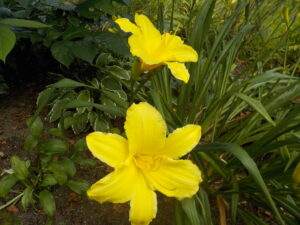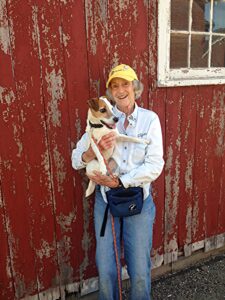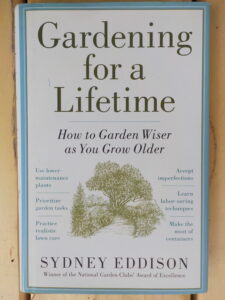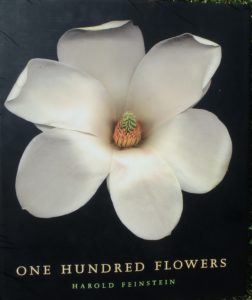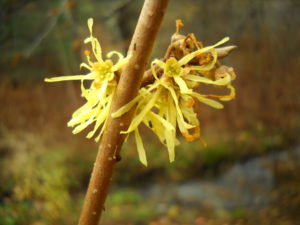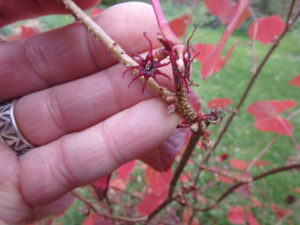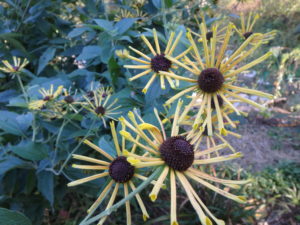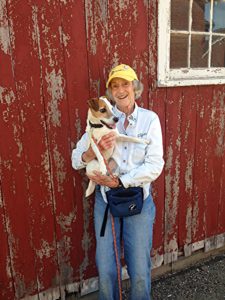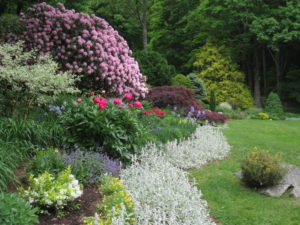Gardening Better As We Age
As a Certified Senior Citizen I sometimes wonder if I am too ambitious in my garden. I have about an acre of gardens with 200 or more kinds of flowers and a good-size vegetable garden. These gardens please me greatly, and I visit them daily all year, even in winter. In gardening season I spend considerable time weeding, pruning, mulching and admiring our gardens. I am blessed with a wife who loves to garden, and even loves weeding and edging!
Raised beds make gardening easier on us, too. I have one nice deep cedar gardening “trug” that is six-feet by two and a half-feet in size and stands 30 inches tall. I got it from Gardeners Supply several years ago and it has held up well. I grow mostly kitchen herbs in it, along with a little lettuce and a few hot peppers. It is just steps from the house, while the vegetable garden is downhill and a few hundred steps away. I might get another, or build one.
I recently called my friend Sydney Eddison at her home in Connecticut to talk about gardening as we get older. She is the author of many gardening books and a few nice small books of poetry in recent years. Her book, “Gardening for a Lifetime: How to Garden Wiser as You Grow Older” (Timber Press, 2010) if full of good ideas.
Sydney Eddison gave me good advice: if someone offers to help in the garden, accept! And if no one does offer, try to hire a younger person to help. Offer to teach them about gardening and both of you will be happy. At the end of the day sit in the garden and drink tea and eat homemade cookies. Both of you will be happy.
Understanding Flowers
At a recent used book sale I purchased a copy of a lovely book called One Hundred Flowers by Harold Feinstein (Bullfinch Press, 2000). This large-format book includes not only 100 amazing, huge close-up photos of flowers against black backgrounds, it has a lovely introductory essay by Sydney Eddison, a dear friend and fellow gardener writer. Sydney’s introduction is thought-provoking, and worthy of discussion here.
Ms. Eddison begins by explaining the purpose of flowers: to allow plants to reproduce and set seed. For annuals, flowers like cosmos or sunflowers, have but one chance to extend their genetic line. Failing to create seed and have that seed planted – by gravity, an animal or by a gardener – an annual is lost forever at the end of the season. It is generally an advantage for an annual to produce lots of seeds, in hopes that at least one will grow and extend the lineage.
Annuals must reproduce, and consequently they are excellent advertisers – they often have bright colors or strong scents to attract bees or other pollinators. Other annuals depend on the wind to pollinate them, and they need not be so bright – think wheat or corn. Still, the genetic lineage of an annual plant ends if seeds are not produced. Of course many seeds will remain viable for years, and most species have plenty of specimens trying to extend the lineage each year.
Perennials, trees and shrubs, by contrast, can go dormant, and live through winter for another chance to get their genes spread. Perennials generally die back at the onset of winter, but their roots go dormant until spring. Biennials, things like foxgloves, are more like annuals – they only flower once, in their second year.
In her essay, Sydney Eddison did a concise Anatomy and Physiology 101. Most flowers, but not all, have both male and female reproductive organs, generally on the same flower. But it is to the advantage of plants to cross pollinate with other flowers of the same species, and they have evolved to do so. Just as we don’t generally marry our sisters or cousins, flowers get vigor and new traits by crossing with other flowers.
How do plants insure that they are not self-pollinating? One way has to do with timing. Sydney Eddison gives the example of sunflowers. Each “flower” is actually a collection of hundreds to tiny flowers all jammed together, but using one set of bright yellow petals to attract pollinators. That’s efficiency personified.
The stigma, or the female part of the sunflower that is receptive to male pollen is delivered by bees or other pollinators, but it stays closed while a particular sunflower is shedding pollen. Later, another pollinator, attracted by those bright yellow petals, will deliver pollen from a different plant.
Many flowers seemingly make pollination difficult. Nectar or pollen is hidden away deep inside a flower. An industrious bee must crawl inside to get at the goodies. In so doing, the bee or other insect delivers pollen, the male gametophytes, from one flower to another. In the fall I love the sound of bees grumbling about their hard life after they finally force themselves inside turtle head, which is one of my favorite flowers of the season.
Flowers entice us just as readily as they do butterflies, bees and moths. We love them and we grow them for beauty as well as for the food they might produce. Humans have been hybridizing plants for eons – long before genetic engineering was even imagined. Creating hybrids can be as simple as breaking off a pollen-laden anther from one variety of flower and touching it to the female stigma on another. Then saving seed, planting it, and seeing what you get.
But once again, timing can be key. If the wind or a big, fat bumblebee has already pollinated a flower, your efforts may not create anything different. But, as Ms. Eddison points out, hybridizers have been dreaming of blue lilies and black gladiolas, and trying their best to produce them – for decades without luck so far.
If you want to try hybridizing flowers, you can “bag” a flower before it opens to prevent accidental pollination. Daylilies are easy to do this with – just use a small paper or wax bag that you place over an unopened flower and secure with a rubber band or piece of yarn. Not every daylily, even ones you pollinate, produce seeds, however. And a friend who has done this hundreds of times explained that most crosses don’t produce anything of interest.
Genetic engineering –made possible just within the last 25 years – allows scientists to add genes to the make-up of organisms in ways unfathomable to Gregor Mendel, who proposed the laws of genetic inheritance in 1865. So for example, back in 2003 I interviewed scientist, Dr. Mark Brand at UConn who introduced genes from a frog into a rhododendron to help it be less susceptible to a fungal root rot. That is not something you or I could do – or would I want to.
Green plants first appeared some 400 million years ago. They evolved from aquatic algae to mosses to ferns to flowering plants. The first flowering plants appeared about 300 million years ago and now there are estimated to be 400,000 distinct species. And remember: all animals on this planet depends on plants, either directly or indirectly. They are not just decoration, they sustain us all. So go garden. Your plants depend on you as much as you depend on them.
Henry Homeyer is a UNH Master Gardener with over 20 years’ experience, and an organic gardener for well over 50 years. You may reach him at henry.homeyer@comcast.net or P.O. Box 364, Cornish Flat, NH 03746.
Life After Frost: Gardening Is Not Over
Frost was late this year. It was nearly mid-October before we had a hard frost, one that murdered the zinnias and blackened the basil. For me, hard frost is a day to mourn a little, to spend a few moments missing the summer that passed, for the tomatoes that brought me such great pleasure and the flowers that graced my table.
But autumn is grand, too. I still have plenty of garden veggies to harvest and process, and those fall days full of sun and a few monarchs are full of surprises and delights.
I’m always delighted by plants that bloom now –especially woody plants. I have two witch hazels (Hamamelis virginiana) that bloom subtly each fall. The blossoms are not obvious because they are small, yellow, and their leaves are yellow (and green) and have not yet fallen. But those curly blossoms will persist even after the leaves have dropped. Witch hazel is a native tree that lives in shade or part shade. It’s a small tree or a shrub, depending on the variety. It blooms either now, or in very early spring.
Another interesting shrub in bloom now is disanthus (Disanthus cercidifolius). Although most books describe the flowers as “insignificant”, I disagree. They are small – just half in inch across, and close to the stem – but they are in pairs, back to back, each like a small purple starfish. I‘ve had my disanthus for 4 years, and this is the first time it has bloomed, or at least the first time I have seen it bloom. So I yelped with excitement when I first saw the blossoms.
The best thing about disanthus is the leaf color. The leaves are deep red and purple, and have been so for many weeks. The color is better than that of the now prohibited invasive, burning bush (Euonymus alatus). But unlike burning bush, disanthus doesn’t litter the countryside with babies like a stray, unspayed dog. It stays in one place, and grows slowly to a 6 to 10 foot height and width.
In the flower garden my fall asters are about done, but I still have one Rudbekia or black-eyed Susan looking great. It is Rudbeckia subtomentosa, a variety called ‘Henry Eiler’. It’s taller than I am. Its petals are very delicate and are spaced apart in an airy fashion. The stems of this plant are quite thick, but not thick enough to stand up to fall winds without staking.
Grasses are nice now, too. They generally bloom in fall, producing subtle green flowers that most people don’t recognize as flowers. My favorite grass is a Chinese feather grass (Miscanthus sinensis), a variety called ‘Morning Light’. The leaves have a central white stripe and each stem stands up 4 to 6 feet, or even more. This grass will look good all winter waving above the snow.
Each stem of feather grass has 20 or so thin strands of flowers that will produce seeds. This plant does not reproduce from seed, however. The clump gets bigger each year, and can be divided to create more plants. I’ve read that the time to divide it is in the spring, not now.
The milkweed plants I started from seed this year stayed small and did not flower. But I will harvest some seeds elsewhere and plant some more. The seeds need a cold period before they will germinate, so planting outside now makes sense. Last spring I planted seeds in flats indoors, then put them in the fridge for 6 weeks before they would grow. The red milkweed I planted the year before did great this year, blooming and attracting pollinators. I will plant some of their seeds when I see the pods are ripe and ready to burst open.
I’ve cut down some of my perennials, and pretty much all are ready for the knife or shears. I’ll leave things with stiff stems and interesting seed pods for winter viewing and as food for the birds. But the more I can do now, the better. One landscaper told me she figured that every hour of fall clean up reduces spring work by three hours.
One of my last tasks each year is to run over the lawn with my lawnmower, chopping leaves into perfect mulch. I rake it onto a tarp and pull the tarp to my vegetable garden where I spread the leaves over the by-then weeded beds. It keeps weed seeds from germinating in the spring, and adds organic matter to the soil as it breaks down and is eaten by earthworms.
My gardening friend and fellow garden-book writer Sydney Eddison of Connecticut always saves her chopped fall leaves in contractor bags and uses them in the spring on her flowers. I have filled up 6 huge plastic bags with grass clippings and leaves another friend gave me, and have stored them in the barn for use in the spring. Sydney Eddison has the best soil I’ve ever seen after mulching with chopped leaves for 40 years or so.
Don’t forget to plant your spring bulbs now, too. You can plant into November, but it will be cold by then, so get going!
Read Henry’s blog at https://dailyuv.com/
Books by Sydney Eddison
Photos: K Day Designs
I’m a fairly simple person. I like dogs and flowers and good food. Having friends is important. I like to grow vegetables from seed, and I revere trees that have survived longer than I have. And when it comes to poetry, I like it simple and direct, poetry that evokes images of nature and emotions I can understand. So it was a great pleasure when my friend the garden writer Sydney Eddison sent me her new book of poetry, Fragments of Time: Poems of gratitude for everyday miracles (Pomperaug Valley Press, 2016).
Fragments of Time is a lovely book of poems, many that focus on Ms. Eddison’s gardens and her love for the outdoors. But a few are love poems about her late husband, one is a sad reminder of the Newtown School shooting which occurred in her town. Others are happy memories of children, dogs, squirrels and seasons changing. These are poems I have enjoyed reading out loud to loved ones.
You might relate to this fragment of a poem:
Dandelions, bold and unapologetic,
seize empty spaces between perennials
and drive down taproots.
The lines are drawn.
Let the battle begin!
I know Sydney Eddison best as a gardener and garden writer. I first visited her in 2000 after I read her book, The Self-Taught Gardener: Lessons from a Country Garden (Viking/Penguin, 1997) and knew she was someone I wanted to meet. The book taught me much – even though I was at the time already writing a gardening column and considered myself a fairly accomplished gardener.
Thumbing through it now, I see I can learn from it even now – and should re-read it. For example, she points out that most silver-leafed plants do best in dry soil. I never thought of it that way.
When I first visited Sydney in her garden in Connecticut it was in the middle of a ferocious drought. There was a ban on watering plants and washing cars, and had been for six weeks. Yet the soil in her flower beds was fluffy and lightly moist. Oaks in the woods were showing signs of stress, but her gardens were not. Had she been cheating, I asked?
“Not a bit,” she replied. She explained that for decades her husband, Martin, had been chopping up fall leaves with the lawn mower and storing them in the barn in bags until spring when she used them as mulch. The 3-inch layer held in moisture and protected the soil from the summer sun. Earthworms love them, too, she said. Like all her advice, this was given out in the spirit of a friendly auntie who wanted the best for you. I’ve been mulching with chopped leaves ever since.
Her book The Gardener’s Palette (Contemporary Books, 2003) taught me the basics of color theory. Among other things, it explains the importance of the color wheel and understanding the principles of contrast and harmony. It has color photos on nearly every page to illustrate her points. I agree with her final synopsis:
“With nature providing an abundance of soft, neutral tones and peace-keeping green leaves, no gardener with keen eyes can go that far wrong. And at the risk of oversimplifying a complex subject, I still maintain that color for gardeners isn’t so complicated after all.”
Then in 2005 Sydney came out with Gardens to Go: Creating and Designing a Container Garden (Bulfinch Press, 2005). As she explained in the beginning, “In terms of design, a container garden should have boundaries, bone structure, and geometry, just like any other garden.” She added, “As you will soon see, a container garden is the real thing, a living three-dimensional picture, rich in plant material every bit as exciting as an in-the-ground garden.”
Sydney’s most recent gardening book, Gardening for a Lifetime: How to Garden Wiser as You Grow Older (Viking Press, 2010) is, perhaps, her final gardening book. Written as she approached the age of 80, she recognized that she was no longer strong as on ox and able to wrestle boulders out of the ground. That a paid helper in the garden is good, if you can afford one; that it is all right to accept imperfections and to use lower-maintenance plants – even if it means giving up some old favorites.
I feel honored that I have been included in Sydney Eddison’s group of gardening friends. Her books, some of which are (or should be) in your library, are all worth reading. What a delight to see a friend develop a new skill, publishing poetry now, in her ninth decade of living joyfully on this earth – with fabulous gardens and always with a Jack Russell terrier at her side – or zooming ahead.
Read my twice-weekly blog at www.dailyUV.com/gardeningguy




